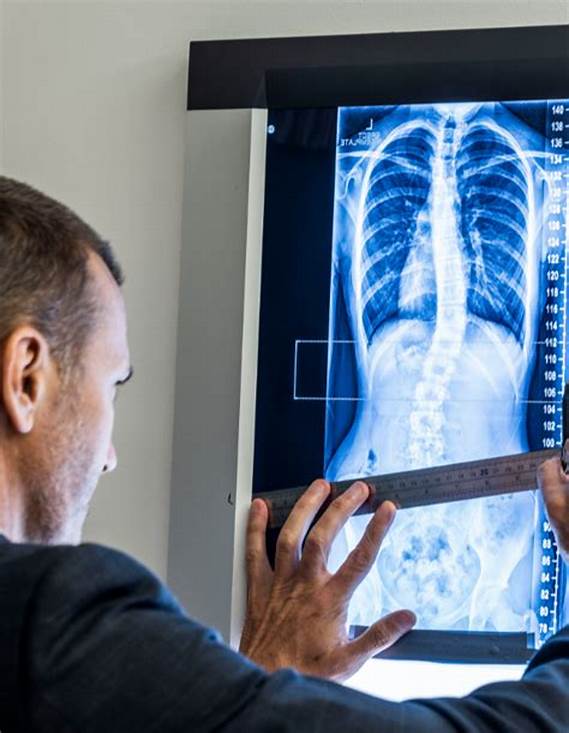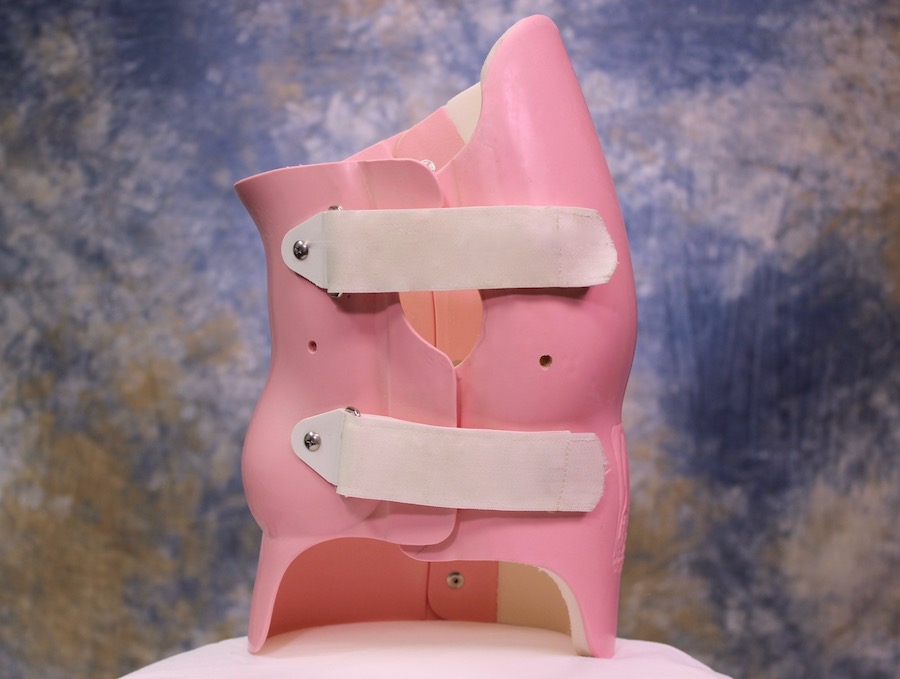Thoracolumbar scoliosis is a specific type of scoliosis that affects the thoracic and lumbar regions of the spine. Scoliosis is a condition characterized by an abnormal curvature of the spine, which can cause pain, discomfort, and functional limitations. Thoracolumbar scoliosis specifically refers to a curvature that occurs in the middle and lower back, between the thoracic and lumbar vertebrae.
Definition and Classification of Thorocolumbar Scoliosis
Thoracolumbar scoliosis is defined as a lateral curvature of the spine that measures greater than 10 degrees in the thoracic and lumbar regions. It is classified based on the direction and location of the curve. The direction of the curve can be either to the right (dextroscoliosis) or to the left (levoscoliosis). The location of the curve is determined by the vertebrae involved, such as thoracic, lumbar, or both.
Causes and Risk Factors of Thorocolumbar Scoliosis
The exact cause of thoracolumbar scoliosis is often unknown, but there are several factors that can contribute to its development. Some common causes include congenital abnormalities, neuromuscular conditions (such as cerebral palsy or muscular dystrophy), genetic factors, and idiopathic scoliosis (which has no known cause). Risk factors for developing thoracolumbar scoliosis include a family history of scoliosis, female gender, and rapid growth during adolescence.

Understanding the Symptoms of Thorocolumbar Scoliosis
The symptoms of thoracolumbar scoliosis can vary depending on the severity of the curvature. Mild cases may not cause any noticeable symptoms, while more severe cases can lead to pain, stiffness, and difficulty with activities of daily living. Other symptoms may include uneven shoulder or hip heights, a visible curvature of the spine, and muscle imbalances.
Diagnosis and Evaluation of Thorocolumbar Scoliosis
Diagnosing thoracolumbar scoliosis typically involves a thorough physical examination, including a visual assessment of the spine and a measurement of the curvature using a scoliometer or X-rays. Additional tests, such as MRI or CT scans, may be ordered to evaluate the underlying cause of the scoliosis. It is important to accurately diagnose and evaluate thoracolumbar scoliosis to determine the appropriate treatment approach.
Imaging Techniques for Thorocolumbar Scoliosis
Imaging techniques play a crucial role in the diagnosis and evaluation of thoracolumbar scoliosis. X-rays are commonly used to measure the degree of curvature and assess the alignment of the spine. MRI and CT scans can provide more detailed information about the underlying structures and any associated abnormalities. These imaging techniques help guide treatment decisions and monitor the progression of the scoliosis over time.

Non-Surgical Treatment Options for Thorocolumbar Scoliosis
Non-surgical treatment options for thoracolumbar scoliosis are typically recommended for mild to moderate cases that do not cause significant pain or functional limitations. These options may include observation, physical therapy, and bracing. Observation involves monitoring the progression of the scoliosis over time without intervention. Physical therapy aims to improve posture, strengthen the muscles supporting the spine, and increase flexibility. Bracing is often used in growing children to prevent further progression of the curvature.
Bracing and Physical Therapy for Thorocolumbar Scoliosis
Bracing is a common non-surgical treatment option for thoracolumbar scoliosis, especially in adolescents who are still growing. The goal of bracing is to prevent the curvature from worsening and to provide support to the spine. The type of brace used will depend on the severity and location of the scoliosis. Physical therapy is often recommended in conjunction with bracing to improve muscle strength, flexibility, and overall function. Physical therapists can provide specific exercises and stretches tailored to the individual’s needs.

Surgical Treatment Approaches for Thoracolumbar Scoliosis
Surgical treatment for thoracolumbar scoliosis is typically reserved for severe cases that cause significant pain, functional limitations, or cosmetic concerns. The goal of surgery is to correct the curvature and stabilize the spine. There are several surgical approaches that can be used, including spinal fusion, instrumentation, and osteotomy. Spinal fusion involves fusing the affected vertebrae together to create a solid bone mass. Instrumentation refers to the use of rods, screws, or wires to hold the spine in the corrected position. Osteotomy involves removing a portion of the bone to allow for better alignment of the spine.
Postoperative Care and Rehabilitation for Thorocolumbar Scoliosis
After surgery for thoracolumbar scoliosis, postoperative care and rehabilitation are crucial for a successful recovery. This may include pain management, wound care, and physical therapy. Pain management techniques may include medications, ice or heat therapy, and relaxation techniques. Wound care involves keeping the surgical incision clean and dry to prevent infection. Physical therapy is an essential component of rehabilitation and focuses on regaining strength, flexibility, and function. Physical therapists will provide a personalized treatment plan based on the individual’s specific needs and goals.
Complications and Prognosis of Thorocolumbar Scoliosis
Complications of thoracolumbar scoliosis can vary depending on the severity of the curvature and the chosen treatment approach. Potential complications may include infection, blood loss, nerve damage, and failure of the surgical hardware. The prognosis for thoracolumbar scoliosis depends on several factors, including the age of onset, the severity of the curvature, and the chosen treatment approach. With appropriate treatment and management, many individuals with thoracolumbar scoliosis can lead active and fulfilling lives.
Future Directions in Thorocolumbar Scoliosis Research
Research in the field of thoracolumbar scoliosis is ongoing, with a focus on improving diagnostic techniques, understanding the underlying causes, and developing more effective treatment options. Advances in imaging technology, such as 3D imaging and computer-assisted navigation, may provide more accurate measurements and better visualization of the spine. Genetic studies are also being conducted to identify specific genes that may be associated with the development of thoracolumbar scoliosis. Additionally, researchers are exploring the use of non-invasive treatments, such as electrical stimulation and exercise programs, to improve outcomes for individuals with thoracolumbar scoliosis.
In conclusion, thoracolumbar scoliosis is a specific type of scoliosis that affects the middle and lower back. It can have various causes and risk factors, and the symptoms can range from mild to severe. Accurate diagnosis and evaluation are essential for determining the appropriate treatment approach, which may include non-surgical options such as observation, physical therapy, and bracing, or surgical interventions like spinal fusion or instrumentation. Postoperative care and rehabilitation are crucial for a successful recovery, and complications and prognosis can vary depending on the individual case. Ongoing research aims to improve diagnostic techniques, understand the underlying causes, and develop more effective treatment options for thoracolumbar scoliosis.
References
- National Scoliosis Foundation: Overview of scoliosis types and definitions. National Scoliosis Foundation
- Mayo Clinic: Information on scoliosis symptoms and causes. Mayo Clinic
- American Academy of Orthopaedic Surgeons: Detailed guide on scoliosis diagnosis and treatment. AAOS
- Spine-health.com: Comprehensive article on thoracolumbar scoliosis. Spine-health
- Johns Hopkins Medicine: Insights into scoliosis imaging techniques. Johns Hopkins Medicine
- Cleveland Clinic: Diagnostic procedures for scoliosis. Cleveland Clinic
- Scoliosis Research Society: Research and information on scoliosis classification. Scoliosis Research Society
- Harvard Health Publishing: Analysis of scoliosis risk factors. Harvard Health
- Orthopaedic Institute: Overview of spinal imaging technologies. Orthopaedic Institute
- PubMed Central: Research articles on scoliosis treatment and outcomes. PubMed Central
- National Institute of Arthritis and Musculoskeletal and Skin Diseases: Information on spinal disorders. NIAMS
- Children’s Hospital of Philadelphia: Details on scoliosis screening methods. CHOP
- American Academy of Pediatrics: Guidelines for scoliosis in children and adolescents. AAP
- British Journal of Sports Medicine: Articles on scoliosis and physical therapy. BJSM
- Journal of Bone and Joint Surgery: Research on spinal curvature measurement techniques. JBJS
